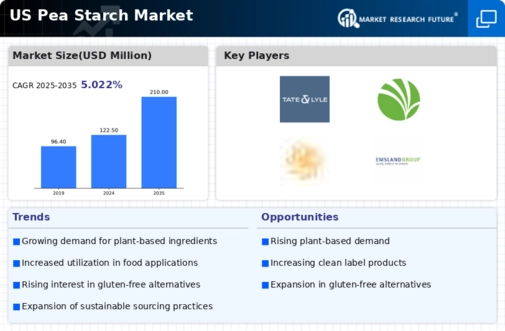Sustainability Initiatives
Sustainability is becoming a pivotal factor influencing the pea starch market. As environmental concerns grow, consumers and manufacturers alike are prioritizing sustainable sourcing and production methods. Pea starch, derived from legumes, is often viewed as a more sustainable alternative to traditional starch sources. The pea starch market is likely to see increased demand as companies adopt eco-friendly practices and promote their products as sustainable options. Furthermore, the U.S. government has been encouraging sustainable agricultural practices, which may lead to enhanced production of peas and, consequently, pea starch. This alignment with sustainability goals could potentially enhance the market's growth trajectory, as consumers increasingly favor products that contribute to environmental preservation.
Versatility in Applications
The versatility of pea starch across various industries is a significant driver for the pea starch market. It is utilized in food products, personal care items, and even bioplastics, showcasing its broad applicability. In the food sector, pea starch serves as a thickener, stabilizer, and emulsifier, making it a valuable ingredient in sauces, soups, and dairy alternatives. The personal care industry also leverages pea starch for its binding and thickening properties in cosmetics and skincare products. This diverse range of applications indicates a robust demand for pea starch, with the market projected to reach approximately $500 million by 2026. The pea starch market is thus well-positioned to capitalize on its multifunctional nature, appealing to a wide array of manufacturers seeking innovative solutions.
Growing Health Consciousness
The increasing awareness of health and wellness among consumers is driving the pea starch market. As individuals seek healthier dietary options, the demand for plant-based ingredients, including pea starch, is on the rise. This trend is particularly evident in the food and beverage sector, where pea starch is utilized as a thickening agent and stabilizer. According to recent data, the market for plant-based food products is projected to grow at a CAGR of approximately 11% through 2027. This growth is likely to bolster the pea starch market, as manufacturers incorporate it into various products to meet consumer preferences for healthier alternatives. The pea starch market is thus positioned to benefit from this shift towards health-oriented consumption patterns, as more brands seek to align their offerings with the evolving demands of health-conscious consumers.
Rising Demand for Gluten-Free Products
The growing demand for gluten-free products is a notable driver for the pea starch market. As more consumers adopt gluten-free diets due to health concerns or lifestyle choices, the need for gluten-free alternatives has surged. Pea starch serves as an excellent substitute in gluten-free formulations, providing the necessary texture and binding properties that are often lacking in gluten-free products. The market for gluten-free foods is expected to grow at a CAGR of around 10% through 2026, which could significantly boost the demand for pea starch. The pea starch market is thus likely to experience growth as manufacturers increasingly incorporate pea starch into their gluten-free offerings, catering to the needs of this expanding consumer segment.
Technological Advancements in Production
Technological advancements in the production of pea starch are significantly impacting the market. Innovations in extraction and processing techniques have improved the efficiency and yield of pea starch production. These advancements not only enhance the quality of the starch but also reduce production costs, making it more competitive against other starch sources. The pea starch market is likely to benefit from these technological improvements, as manufacturers can produce higher-quality products at lower prices. Additionally, the integration of automation and smart technologies in production processes may further streamline operations, leading to increased output and profitability. As these technologies continue to evolve, they could potentially reshape the landscape of the pea starch market.

















Leave a Comment